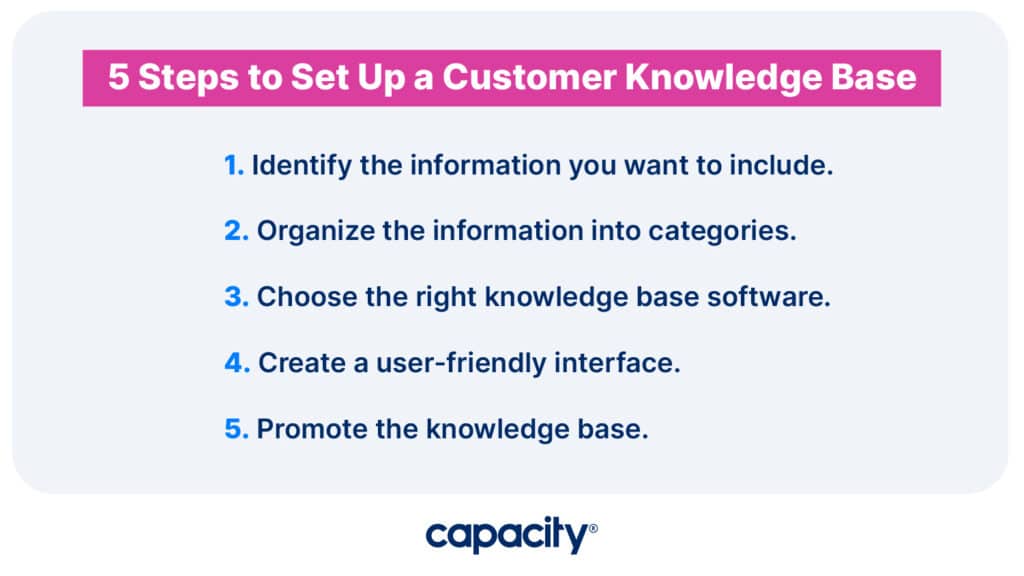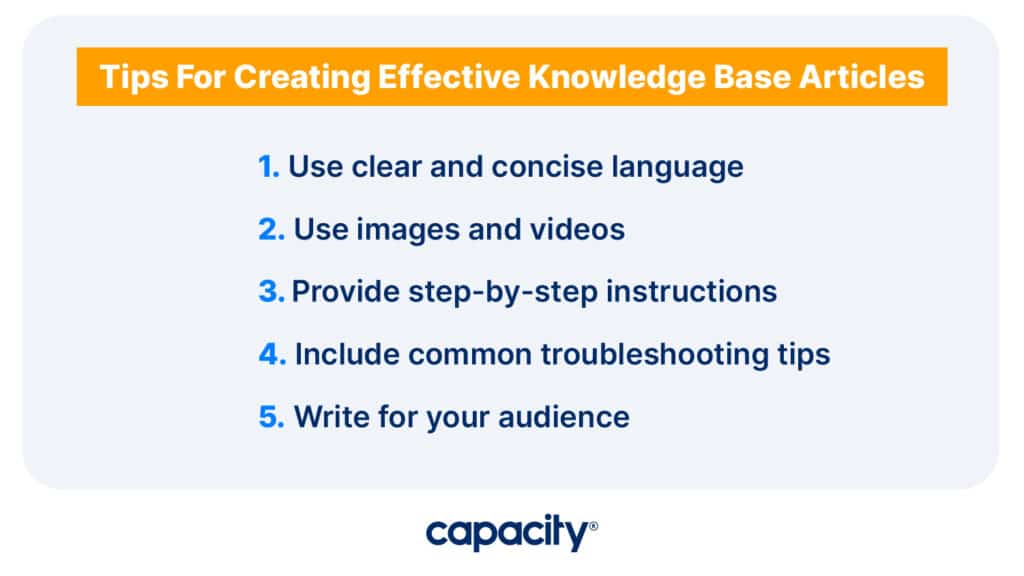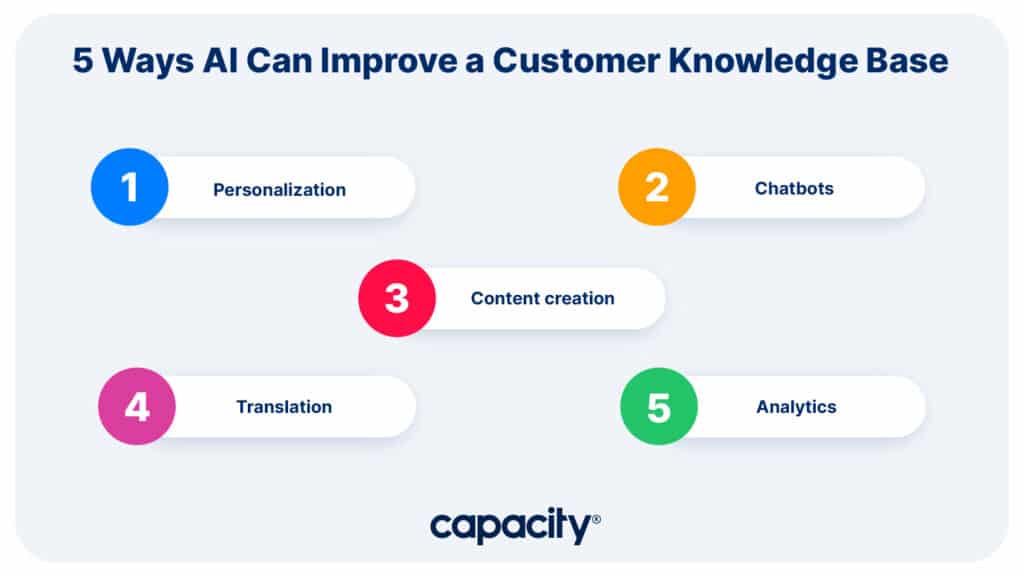Did you know that 73% of customers want to solve their product or service issues on their own? In fact, the same report from Aspect (now Alvaria) found that customers would rather clean a toilet than talk to customer service. Yikes!
Enter self-service.
Stellar self-service lets your customers find the answers they need easily and instantly. Which, as a matter of fact, is pretty important. A study by Forrester found another 73% of customers said valuing their time is the most important thing you can do for their service.
Self-service can come in a ton of different forms, be it a chatbot, SMS, or something else. But here, we’re focusing on the foundation of every successful self-service interaction. Your customer knowledge base.
What is a customer service knowledge base?
A customer service knowledge base is a centralized repository of information. Often it includes your FAQs, troubleshooting guides, and solutions to common problems.
It’s designed to give your customers a way to solve their own issues. And that saves time (and money) for both you and your customers. A well-designed customer knowledge base can help folks find answers without contacting support.
Five steps to set up a customer knowledge base
Here’s how to get started:

Step 1: Identify what information you want to include in your knowledge base
The first step in setting up a customer knowledge base is figuring out what you want to include in it. Then, work with your agents, managers, and other stakeholders to gather the information.
Step 2: Organize the information into categories
Once you’ve IDed what you want to include, organize it into categories. Doing so will help your customers navigate your knowledge base.
Try to group info into categories like product info, troubleshooting guides, and FAQs. And then figure out other categories that fit your unique business case.
Step 3: Choose the right knowledge base software
There are a ton of different knowledge base software available. And so, it’s important to choose the right one for your unique business needs.
Some of the best customer knowledge base software are:
- Capacity
- Zendesk
- Freshdesk
- Salesforce Knowledge
When you’re looking at the software, think about the ease of use, customization, and how it’ll integrate with your existing systems.
Step 4: Create a user-friendly interface
Creating a user-friendly interface is crucial for the success of your knowledge base. The interface should be easy to navigate and let customers find what they need quickly. A search bar, clear headings, and a simple layout can make your knowledge base more user-friendly.
Step 5: Promote the knowledge base
Once the knowledge base is set up, promoting it to your customers is important. You can do this through email campaigns, social media, and other marketing channels. Consider offering incentives for customers who use the knowledge base. Maybe that’s a discount or exclusive content.
By promoting the knowledge base, you can support customers using the self-service options. And that then reduces the workload on your support team.
Do customers prefer video or text in a knowledge base?
When it comes to customer knowledge base preferences, there is no one-size-fits-all answer. Some customers prefer video tutorials because they can easily see and understand how to use a product or resolve an issue. But others like written documentation as it lets them go at their own pace and review information as needed.
But, offering video and text options in your knowledge base can cater to different learning styles and preferences. And that makes the knowledge base more accessible and useful for a wider range of customers.
What’s more, you can add images and diagrams alongside text or video. This will help customers better understand the most complex concepts. The key here is to give them the most comprehensive, well-organized source of info in as many formats as possible. That then gives customers the control to choose what works best for them.
Using AI in a knowledge base can also be helpful. It can suggest articles or videos based on a customer’s search query or behavior. And that can make it easier for them to find the information they need.
Tips For Creating Effective Knowledge Base Articles

Here are the tips:
- Use clear and concise language: Use language that is easy to understand and avoids technical jargon or complex terminology. Write in a conversational tone and keep sentences short and to the point.
- Use images and videos: Incorporate images, diagrams, and videos into your articles to make them more engaging and easy to follow. Visual aids can help readers better understand complex concepts.
- Provide step-by-step instructions: Use numbered lists or bullet points to provide step-by-step instructions for completing a task or resolving an issue. And, of course, make sure the instructions are clear and easy to follow.
- Include common troubleshooting tips: Anticipate common issues or questions and then provide troubleshooting tips or workarounds in your articles. This can help customers resolve issues independently and reduce your support team’s workload.
- Write for your audience: Consider who your audience is and what they are looking for. Use language and examples that are relevant to them and address their needs and pain points.
By following these tips, you can create effective knowledge-based articles that provide clear, concise, and helpful information for your customers.
Integrating your Knowledge Base with other Customer Support Channels
Integrating your knowledge base with other customer support channels is crucial for ensuring that your customers can access the information they need whenever and wherever they need it.
Here are some steps to help you integrate your knowledge base with other customer support channels:
1. Identify your customer support channels:
Identify the channels your customers use to contact your team. Are they finding you through email, phone, live chat, social media, etc.?
2. Choose a knowledge base platform with integrations:
Choose a knowledge base platform that offers integrations with your customer support channels.
3. Set up the integrations:
Once you’ve chosen a platform, set up the integrations for each of your customer support channels.
4. Sync your content:
Once the integrations are set up, sync your knowledge base content with your support software.
The role of AI in improving the customer knowledge base
Artificial intelligence (AI) is increasingly important in improving customer knowledge bases. Here are some of how AI is being used:

Personalization
AI can analyze customer behavior and preferences to provide personalized recommendations. You can use this to serve up the right articles or videos in the knowledge base at the right time. And then that can help customers find the information they need more quickly and easily.
Chatbots
AI-powered chatbots can answer common questions and solve problems in real time. They can also direct customers to relevant articles or videos in the knowledge base.
Content creation
AI can analyze customer interactions to find gaps in your content and suggest new articles or videos to fill those gaps. This can help ensure that the knowledge base stays up-to-date and relevant.
Translation
AI can automatically translate articles or videos in the knowledge base into different languages. This makes it easier for all your customers, no matter what language they speak, to access the right info.
Analytics
AI can analyze customer interactions with the knowledge base to ID patterns and trends. You can then use it to find common issues or questions. And you can use it to improve your content and organization of the knowledge base.
AI can help make customer knowledge bases more efficient, effective, and personalized. It can give customers the information they need quickly and easily. All while reducing the workload on support teams and improving the customer experience.
Best Customer Knowledge Base Software
Here are the best customer knowledge base software options:

Capacity
I know what you’re thinking, but we’re really not (completely) biased here. Our AI-powered support automation platform is one of the best on the market. It has an intelligent knowledge base that fuels our conversational AI. And then the developer platform and flexible database give you easy integration with a ton of different apps. (Think like Slack, Teams, email, etc.)
Our knowledge management system lets you create several query variations. In fact, our new automated inquiry generator means you can proactively create variants in seconds.
Key Features:
- AI-powered support automation platform
- Graceful human handoffs and intuitive task management
- Powerful workflow automation suite
- Robust developer platform
- Flexible database that can be deployed anywhere
- All-in-one helpdesk to answer more than 90% of FAQs and reduce tickets
- Low-code workflows for automating processes and increasing productivity
- User-friendly knowledge base and conversational interface
- App integrations for easy integration with other systems
Zendesk
Zendesk is a cloud-based customer service platform. It offers several tools and features that’ll help your customer support team.
Key Features:
- Easy-to-use platform with customizable templates for creating knowledge-base articles
- Advanced search and analytics tools to monitor and optimize content performance
- Integration with other systems for seamless knowledge management
- Automatic article suggestions based on customer inquiries
- Collaboration features for teams to work together on article creation and updates
Freshdesk
Freshdesk is a cloud-based customer support platform. It has knowledge management that creates, organizes, and automates support processes.
Key Features:
- AI-powered self-service tools for customers to find answers quickly and efficiently
- Advanced analytics and reporting
- Integration with a variety of other systems for seamless knowledge management
- Automatic article suggestions based on customer inquiries
- Collaboration features for teams to work together on article creation and updates
Salesforce Knowledge
Salesforce Knowledge is a cloud-based knowledge management system. It has a bunch of tools for creating, organizing, and automating your support process.
Key Features:
- Customizable article creation and management tools with templates for easy use
- Advanced search and analytics tools to track and optimize content performance
- AI-powered recommendation and translation features for global audiences
- Integration with other Salesforce products for seamless knowledge management
- Automatic article suggestions based on customer inquiries
ProProfs Knowledge Base
ProProfs Knowledge Base is a cloud-based knowledge management system. It offers several tools and features for creating, organizing, and automating support processes.
Key Features:
- User-friendly interface with customizable article creation and organization tools
- Advanced search and analytics tools to track and optimize content performance
- Customizable design for the knowledge base
- Automatic article suggestions based on customer inquiries
- A built-in survey tool for gathering feedback from customers and improving content quality

Automate Your Work
Capacity’s enterprise AI chatbot can help:
- Answer FAQs anytime, anywhere
- Find relevant documents within seconds
- Give surveys and collect feedback





